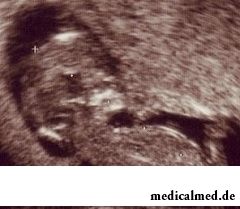





Ventrikulomegaliya
Ventrikulomegaliya represents pathological change at a fruit at which there is a small or significant increase in the sizes of ventricles of a brain that leads to neurologic disturbances and diseases of a brain.
Reasons and symptoms of a ventrikulomegaliya
The pathological ventrikulomegaliya at a fruit can carry as the isolated character, and to be the defect connected with other pathologies of development. At this disease at a fruit the big size of the ventricles of a brain reaching up to 12-20 mm is observed.
In modern medicine distinguish chromosomal anomalies which are observed at 17-20% of women with pathologies at pregnancy from the main reasons for a ventrikulomegaliya.
Obstructive hydrocephaly, physical injuries, infectious diseases, hemorrhage and hereditary factors can be the reasons of a ventrikulomegaliya. Pathology amplifies with other anomalies of development.
Ventrikulomegaliya at a fruit can lead to development in the child of a Down syndrome, Turner and Edwards's syndrome. This disease influences changes of structures of a brain, heart and musculoskeletal system.
Symptoms of a ventrikulomegaliya can be revealed clearly by means of ultrasonography, and their emergence is noticeable on 20-23 week of pregnancy. In certain cases pathology is fixed at the beginning of the third trimester of pregnancy, the best period of diagnosing and identification of symptoms of a disease are 25-26 week.
If the ventrikulomegaliya is single pathology at a fruit, then probability of heavy disturbances of chromosomes low. The attending physician defines risk of development of diseases of a brain in the child according to increase in width of ventricles.
Medical researches established that the risk of emergence of a ventrikulomegaliya is high at pregnant women aged from 35 years (frequency of diseases makes 0,5-0,7%), and at young women in labor it is considerably reduced.
In pediatrics distinguish three main types of a ventrikulomegaliya:
- the heavy type with existence of big increases in ventricles of a brain of a fruit or the newborn and also which is combined with other pathologies of a brain;
- average type with increase in ventricles up to 15 mm and little changes in liquor outflow;
- easy type which has single character and does not demand serious treatment.
Diagnosis of a disease
Ventrikulomegaliya is diagnosed during pregnancy (from 17 to 33 week) by means of ultrasonography and spectral karyotyping of a fruit. Perinatal inspections have to include studying of all anatomical structures of a fruit, especially ventricular system of a brain.
For establishment of the exact diagnosis carry out cross scanning of the head of a fruit with determination of threshold size of side cerebral cavities. Ventrikulomegaliya is defined at the size of ventricles more than 10 mm.
Treatment of a ventrikulomegaliya
The main treatment of a ventrikulomegaliya is directed to prevention of emergence of effects of this pathology which can be a serious illness of a brain and central nervous system.
The pediatrician and the neurologist as medicamentous therapy appoint reception of antigipoksant, diuretics and vitamins.
For treatment of a ventrikulomegaliya appoint massage and physiotherapy exercises (static exercises with loads of pelvic muscles and a pelvic bottom).
As the medicines intended for prevention of development in the child of neurologic disturbances appoint the drugs directed to keeping of potassium in an organism.
The weight of a human brain makes about 2% of all body weight, however it consumes about 20% of the oxygen coming to blood. This fact does a human brain extremely susceptible to the damages caused by shortage of oxygen.

Not everyone can brag of the shining Hollywood smile. Even at the person who is regularly visiting the stomatologist and watching з...
Section: Articles about health
The modern person not always manages to find housing in the environmentally friendly region and such work which would not do harm to health. With food stuffs at first sight the situation is much better: shops are overflowed with goods which are positioned пр...
Section: Articles about health
All of us, unfortunately, should face flu nearly an every year. It would seem, so frequent disease has to be studied already up and down, and each person, at least once to them had (and the number of such people in our country aims at 100%), has to know the basic rules of its treatment. However as shows experience of doctors, there is no it, and often people, self-confidently thinking what is known as it is necessary to be treated, make mistakes....
Section: Articles about health
High temperature - a frequent symptom of such widespread diseases as a SARS, quinsy, pneumonia, etc. To reduce heat, облег...
Section: Articles about health
The climax, or menopause is the normal process of the termination of genital function of the woman which is followed by serious hormonal changes in an organism. Usually the menopause begins at the age of 50-55 years, but characteristics of this process are very individual. T...
Section: Articles about health
Visit of doctors – business not the most pleasant, and many people do not hurry to undergo necessary planned inspections. Such behavior is extremely thoughtless and improvident. Our health is necessary not only to us: wellbeing of darlings, children, grandsons and aged parents directly depends on as far as we are vigorous and able-bodied. Therefore in time to be inspected – a duty of any modern person. Specialists consider that 7 regular surveys and di are especially necessary for women...
Section: Articles about health
There is a lot of fans of beer in our country. Statistically, on each average Russian (including women and children) in...
Section: Articles about health
There comes the season of issues. Many Russians already dream of outdoor recreation, trips, beautiful seaside beaches. At this time there is no wish to think of problems with health and other unpleasant things, however there are subjects which require attention. Summer...
Section: Articles about health
The pancreas performs two functions in a human body: release of enzymes without which digestion of carbohydrates, fats and proteins, and a producing hormones is impossible. The most important of them - insulin, is the main participant of carbohydrate metabolism normalizing processes of education and utilization of glucose, the main energy source for an organism....
Section: Articles about health
Statistically, at the address to doctors seven of each ten patients complain of a headache. Actually people, periodically...
Section: Articles about health
Beauty shop – the place which is associated only with positive emotions: joy, pleasure, relaxation. However visit of salon where work with biological material of clients, not always harmlessly is conducted. Today it is known Bol...
Section: Articles about health
Feeding by a breast - the integral part of ideal motherhood allowing to come into contact with the kid and to create to it healthy immunity since early years. Nevertheless, this important process in life of mother and child can be saddened laktostazy − by a milk delay in a mammary gland. What main reasons for a laktostaz? How not to allow problems with breastfeeding? Let's consider 10 premises resulting in stagnation of milk at the nursing mother....
Section: Articles about health
Popular joke that there are no healthy people, and is nedoobsledovanny, most of us considers an honest truth, and put that...
Section: Articles about health
One of the major chemical processes happening in a human body are oxidation reactions. They go with participation of fats and carbohydrates which we receive from food, and the oxygen getting to us from air. A main goal of such reactions is it is received...
Section: Articles about health
The pine is one of the most widespread plants of our woods. Its needles and pitch not without reason called by "gallipot" were since ancient times used for strengthening of protective forces of an organism, treatment of avitaminosis, anemia and many other diseases. In recent years wide popularity was gained by the national medicines prepared from pinecones. "Fruits" of a coniferous tree contain a huge amount of vitamins, biologically active agents, antioxidants, phytoncides and other useful to...
Section: Articles about health
Shops of household appliances offer us the huge choice of various devices for the house. Whether there are among this abundance devices which...
Section: Articles about health
The summer of this year in Russia was very ambiguous. Regions suffered from a merciless heat, from pouring rains, the hail from time to time dropped out, then there was again a heat which alternated with rainfall again. Many people suffer from such sharp changes of weather...
Section: Articles about health
Work of a brain is extremely complex and in many respects is not studied yet. It is confirmed also by the features of thought processes which are shown when the person sleeps. Let's tell about some of them....
Section: Articles about health
To look healthy and means well-groomed not only to be pleasant to people around, but also to feel strong, sure and taken place. To Spa...
Section: Articles about health
Aging — natural and inevitable process. Over time our skin loses elasticity, on it saggings are formed, the face form loses former clearness. The procedure of nitevy lifting (nitevy tightening) can successfully solve this problem. In order that it is better познако...
Section: Articles about health
Osteoporosis this general disease which main sign is decrease in density of a bone tissue. On distribution width it takes the fourth place among noninfectious diseases. The illness develops at mature age more often: in our country about a third of women and a quarter of men suffers from it 50 years are more senior....
Section: Articles about health
Within several decades of our compatriots convinced that the use of butter nasty affects on...
Section: Articles about health
Almost each of us during life faced dissatisfaction with own body. At such moments, as a rule, we begin to shame ourselves, urgently we go on the most rigid diet promising minus of 10 kg in a week, or we exhaust ourselves in the gym to полусм...
Section: Articles about health
Proofs of efficiency of Mildronate at treatment of coronary heart disease with stenocardia can be found in many publications of the end of the twentieth century. Researches were conducted since 1984, including placebo - controlled effects. In total clinical tests of Mildronate were carried out for more than thirty years....
Section: Articles about health
The body of the person almost for 60% consists of water. It is so important for normal functioning of an organism that loss of all is ponut...
Section: Articles about health
So, you resolved to lose weight. And now you try to understand what to begin with: from exercise stresses or a diet? And how to make that process of weight loss did not give you an inconvenience, and, on the contrary, brought joy?...
Section: Slideshow

